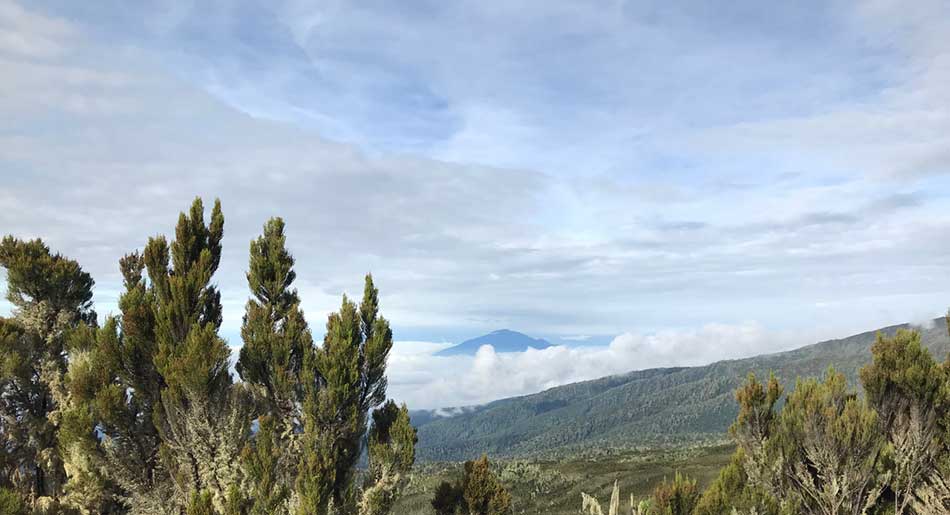Kilimanjaro Trek Day 2 – Machame Huts to Shira Caves
Kilimanjaro Trek Vital Stats
Machame Huts to Shira Caves
- Distance: 3.89 miles
- Starting Elevation: 2981m
- Ending Elevation: 3736m
- Total Climbing: 859m
- Total Descent: 83m
- Highest Elevation: 3789m
- Total Time: 5:28:29
- Moving Time: 1:52:03
- Calories: 1343
- Oxygen Saturation at end of Day: 90%
After no sleep at all, I got out of bed and checked my Oxygen Saturation levels again. They were still at 88% but my resting heart rate was a comfortable 49bpm. As the dark night skies gave way to daylight there was a brief glimpse of the mountain through the trees. It looked a long way off and it’s snow-peaked cap looked like a challenge.
Around camp, huge strings of lichen known as Old Mens Beards were hanging from the trees. I remember my Dad trying to collect tiny versions of this from trees in Dartmoor when I was much younger. He used it to use for making model trees and bushes for his model railways and apparently it was very rare and took decades to grow. There was plenty of it hanging from the trees here – if only he’d known!


Machame Huts to Shira Caves
We packed our bags and then met in the mess tent for breakfast. The usual breakfast affair was a selection of drinks; coffee, tea, Milo etc and then spanish omelettes, pancakes, french toast and plenty of toppings. There was also fruit and afterwards we were given snacks in the form of muffins, biscuits, an apple and a carton of juice to put in our day packs.

After breakfast we headed out of camp into a sunny day as the porters set to work taking everything down and moving it up to the next camp for us. We were getting to know our guides well by now and getting on well with the amazing David our waiter too. We didn’t really know the pilot (toilet porter), the chef or the rest of the proters yet, but I did know Alichongo who was the always cheerful porter responsible for carrying my duffle bag.
As we left camp, we joined a long procession of porters and trekkers as we made our way along the narrow, rocky path. The guide book warns of dust and searing heat on this section of the trail with little protection afforded by the stunted heathers that line the track. Although it started off sunny, were were soon shrouded in clouds, and the recent rains meant that the path was muddy rather than dusty and at times the rocks we had to clamber up were slick and slippery. The trail actually follows the path of a lava flow. We did initially have views to the forests below but most of the time the views were dramatic due to the clouds rather than spectacular.
We did get a nice view of Mount Meru in the distance at one point.

Some people had a little bit of trouble ascending the slippery rocks but there were so many other people around and porters on the trail that help was close at hand. If anything it was a shame just how busy it was as there was no chance of peace and solitude in amongst such a steady stream of people. The porters were of course trying to overtake the trekkers so that they could get to camp before them and have tents etc set up ready for their arrival.
At the top of the lava flow the gradient eased off for a bit as we made out way past huge boulders and rocky outcrops. The heathers were now smaller in size and there were giant lobelias seen in many places. We stopped for lunch after cresting a steep rocky outcrop where ravens prowled the rocks waiting for scraps of leftovers. A bright green grasshopper jumped across the gravel too.
After lunch the trail meandered along the hillside, contouring it rather than climbing much. We passed little waterfalls and tumbling mountain streams as rain started to fall. We eventually reached the Shira Plateau by which time waterproofs were needed. We descended slightly into the Shira Caves Camp.
Shira Caves
Things were quite misty and murky when we first got to camp, but we had a rest and I noticed that my tent was leaking and tried to fix it and mopped up the pools of water with my socks.
After a while we headed off to the caves themselves where Nelson, Hussein and Conrad told us a little about the history of the Chagga people, some things about the Masai people (both of whom were represented within our group of porters) and something of the history of the mountain. The caves themsleves were formed from lava tubes.
The skies cleared a little after this to give us some dramatic views over the Shira Caves Camp and to the clouds beyond so I took my time wandering back to camp and chatted to Conrad. The views to Mount Meru were pretty impressive by now.
I happened to mention the leaking tent to Conrad and as soon as we were back in camp there were about six porters all trying to fix it for me. They were certainly attentive and wanted to make sure everything was OK.
Porters Welcome
After visiting the caves we had the official meet and greet with the entire team of porters. I can’t remember half of their names but it was good to see them all and good to see them enjoying themselves. I’d been careful to choose a company that are affiliate with KPAP which ensures the fair treatment of porters and I was pleased to to see that they all had suitable kit and clothing. Nelson introduced everyone to us and we told them a little about ourselves. It was also interesting to see how genuinely pleased they were to have tourists such as us visiting the mountain. Not only does it provide them all with jobs and a livelihood but they also understood how the park fees that we pay go towards increasing the overall GDP of Tanzania and should ultimately pay for things such as schools, roads and amenities that will benefit their families and improve life in the country.
Poverty is an issue in many Sub-Saharan countries and Tanzania isn’t immune to this. The lives of porters may be a tough one but thanks to KPAP and the tips they get from trekkers such as ourselves, they make a decent living. I don’t know the exact figures but Porters seem to earn about the same as I do annually and guides earn quite a bit more than that. Obviously I’m an exception to the rule in the UK and earn far less than most people so comparing them to my wage is a pointless exercise but it does seem as though most of them are on an above average wage for Tanzania and when you take into account the lower cost of living there they seem quite pleased with their career choices. Life on the mountain is still hard for them though with cramped living conditions, often lower than ideal amounts of food and of course heavy loads to carry over unforgiving terrain. KPAP is going some way to address these issues and is making progress but there is still more to do.
All of our porters all seemed cheerful despite the challenges associated with their jobs when they performed some welcome song and dance for us!
Dinner was a hearty affair that included chicken, beef and fish that went down well. Our health checks were performed, the others were all taking diamox by now and a few of them were beginning to suffer with headaches despite the drugs. I had resisted the urge and didn’t want to take it unless necessary but my oxygen saturation levels were lower than theirs. I’m not sure if this is due to the Diamox or the fact that I was by far the oldest. My back and knee had been a little sore yesterday but were OK today. My Oxygen saturation at camp was 90% and heart rate 78bpm. I felt fine and the walk today had been easy. I felt a little bloated so I told Nelson that during the health check and he told me to fart whenever I wanted and not to hold it in (as if I would). A few minutes later during his briefing for the following day I let rip and blamed Nelson for telling me to do so! Richard in particular found this rather amusing and couldn’t stop laughing. He was still laughing about it once tucked up in his tent for the night.

































Alan, considering the porters at KP-AP registered companies (which is not every company) earn $10 a day, if they were to go up the mountain every day (365 days of the year) they would earn $3,650 a year. Unless you are paid an illegally low wage here in the UK, I don’t think they earn the same that you do. If you do earn less than $3,650 a year I would recommend you find a good lawyer and file a lawsuit against your employer.
Fair points, I wasn’t sure of the exact figures. Here in the UK I do of course earn about 3-4 times more than the $3650 you’ve quoted, but I had included the tips that the porters receive in my calculations as these are a substantial and staple part of their income and I had also taken into consideration the fact that ther cost of living in Tanzania is much lower than here in the UK which does then bring their earnings into closer alignment with mine. I wasn’t for one minute saying that the porters weren’t earning a pittance, I was just pointing out the fact that I’m earning a pittance as well!
Al.